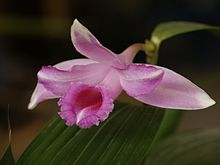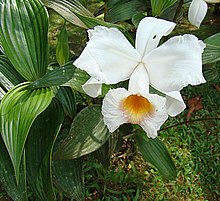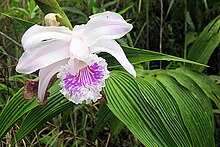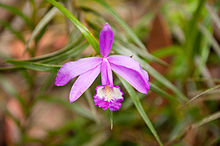Sobralia
| Sobralia | ||||||||||||
|---|---|---|---|---|---|---|---|---|---|---|---|---|

|
||||||||||||
| Systematics | ||||||||||||
|
||||||||||||
| Scientific name | ||||||||||||
| Sobralia | ||||||||||||
| Ruiz & Pav. |
The plant genus Sobralia belongs to the family of orchids (Orchidaceae). The approximately 165 species are distributed in Central and South America.
description

Vegetative characteristics
Sobralia species are perennial herbaceous plants that grow terrestrially , more rarely lithophytically or epiphytically . Often they are quite large and robust, depending on the species, the unbranched stem axis reaches heights of growth from a few centimeters to 10 meters. The roots are fleshy and surrounded by a Velamen radicum two to five cell layers thick .
The leaves are arranged in two rows on the stem and are sessile. The leaf base includes the stem. The leaf blade is usually leathery and firm, rarely thin, but always crinkled to a certain degree along the vein (plicate).
Generative characteristics
The terminal or lateral inflorescence , with or without an inflorescence stem, is simple or branched. The resupinierten flowers usually sit crowded together, so that the bracts is pin-like overlap.
The large, colored flowers open one after the other and usually wither after a day. The plant specimens of a population usually bloom exactly at the same time.
The hermaphrodite flowers are zygomorphic and threefold. The bracts are not fused together and, apart from the lip , are about the same. The petals are sometimes wider than the three outer bracts. The lip is usually more noticeable than the other petals. It has entire margins or three lobes, with the base encompassing the column , spread out further forward, with various ridges or toothed ridges. The column is slender club-shaped, laterally thinly winged, the wings ending in a pair of curved appendages on both sides of the scar . The stigma is bean-shaped, transversely to the column axis, usually a little protruding. The dividing tissue between the stigma and the stamen (rostellum) is large and convex. The two-chambered stamen is at the end of the column and is bent down towards the column axis. The pollinia can be interpreted as eight pieces, two of which are connected, or four pieces that are bent into a U-shape and thus divided into two parts. The consistency of the pollinia is floury.
ecology
Magnificent bees (Euglossini) and bumblebees ( Bombus ) were observed as pollinators in Sobralia species . Sobralia amabilis is pollinated by hummingbirds .
Occurrence
The genus Sobralia is common in the Neotropics . It occurs from Mexico across Central America to the northern half of South America. Sobralia species thrive at altitudes up to 3300 meters.
Systematics
The genus Sobralia was established by Ruiz and Pavón in 1794 . The lectotype is Sobralia dichotoma . The generic name Sobralia honors the Spanish doctor and botanist Francisco Martínez Sobral y Aguliera (? –1799).
The genus Sobralia forms together with Elleanthus and Sertifera the tribe Sobralieae . Within the subfamily Epidendroideae , this tribe represents a basal line. Sobralia is the sister taxon to a clade from the other two genera.
The species of the genus Sobralia was divided into three groups by John Lindley in 1854. It was not until 1983 that Friedrich Gustav Brieger revised this classification, naming the groups and defining types of each. In 2002 there was a revision by Robert L. Dressler , after which there are five sections and some types that are difficult to classify:
- Sect. Abbreviatae Brieger - The inflorescence axis is compressed and densely covered with bracts, the flowers bloom one after the other. With around 50 species the largest section, type species Sobralia fimbriata .
- Sect. Globosae Brieger - The compressed inflorescence axis continues to grow and produces flowers over several growing seasons . Around four species around Sobralia candida .
- Sect. Intermediae Brieger - The inflorescence axis is strongly compressed and densely covered with bracts, each with one or two flowers opening. About 15 species around Sobralia fragrans .
- Sect. Racemosae Brieger - With a long inflorescence axis and long bracts . Around eight species around Sobralia rosea .
- Sect. Sobralia - the section containing the type species ( Sobralia dichotoma ). According to Brieger, characterized by axillary inflorescences, but according to Dressler better characterized by short bracts and the long inflorescence axis. Contains about 13 species.
A list of around 165 recognized species can be found in R. Govaerts.
literature
- Leslie A. Garay: 225 (1). Orchidaceae (Cypripedioideae, Orchidoideae and Neottioideae) . In: Gunnar Harling, Benkt Sparre (ed.): Flora of Ecuador . tape 9 , 1978, ISSN 0347-8742 , p. 110-111 .
- Alec M. Pridgeon, Phillip Cribb, Mark W. Chase (Eds.): Genera Orchidacearum. Epidendroideae (Part one) . tape 4 . Oxford University Press, New York / Oxford 2005, ISBN 0-19-850712-7 , pp. 601-604 .
Individual evidence
- ↑ a b Rafaël Govaerts (Ed.): Sobralia. In: World Checklist of Selected Plant Families (WCSP) - The Board of Trustees of the Royal Botanic Gardens, Kew . Retrieved July 21, 2018.
- ^ A b Leslie A. Garay: 225 (1). Orchidaceae (Cypripedioideae, Orchidoideae and Neottioideae). In: Gunnar Harling, Benkt Sparre (ed.): Flora of Ecuador. Pp. 110-111.
- ↑ a b c d e f Alec M. Pridgeon, Phillip Cribb, Mark W. Chase (eds.): Genera Orchidacearum. Epidendroideae (Part one). Pp. 601-604.
- ↑ Lotte Burkhardt: Directory of eponymous plant names . Extended Edition. Botanic Garden and Botanical Museum Berlin, Free University Berlin Berlin 2018. [1] ( Page no longer available , search in web archives ) Info: The link was automatically marked as defective. Please check the link according to the instructions and then remove this notice.
- ↑ Erik Paul Rothacker: The primitive Epidendroideae (Orchidaceae): phylogeny, character evolution and the systematics of Psilochilus (Triphoreae). (pdf) Ohio State University, 2007, accessed July 31, 2010 .
- ↑ Robert L. Dressler: The major sections or groups within Sobralia, with four new species from Panama and Costa Rica, S. crispissima, S. gloriana, S. mariannae and S. nutans . In: Lankesteriana . No. 5 , 2002, p. 9-15 ( ucr.ac.cr [PDF]).
Web links
- List of orchid genera
- Rafaël Govaerts (Ed.): Sobralia. In: World Checklist of Selected Plant Families (WCSP) - The Board of Trustees of the Royal Botanic Gardens, Kew . Retrieved July 21, 2018.






